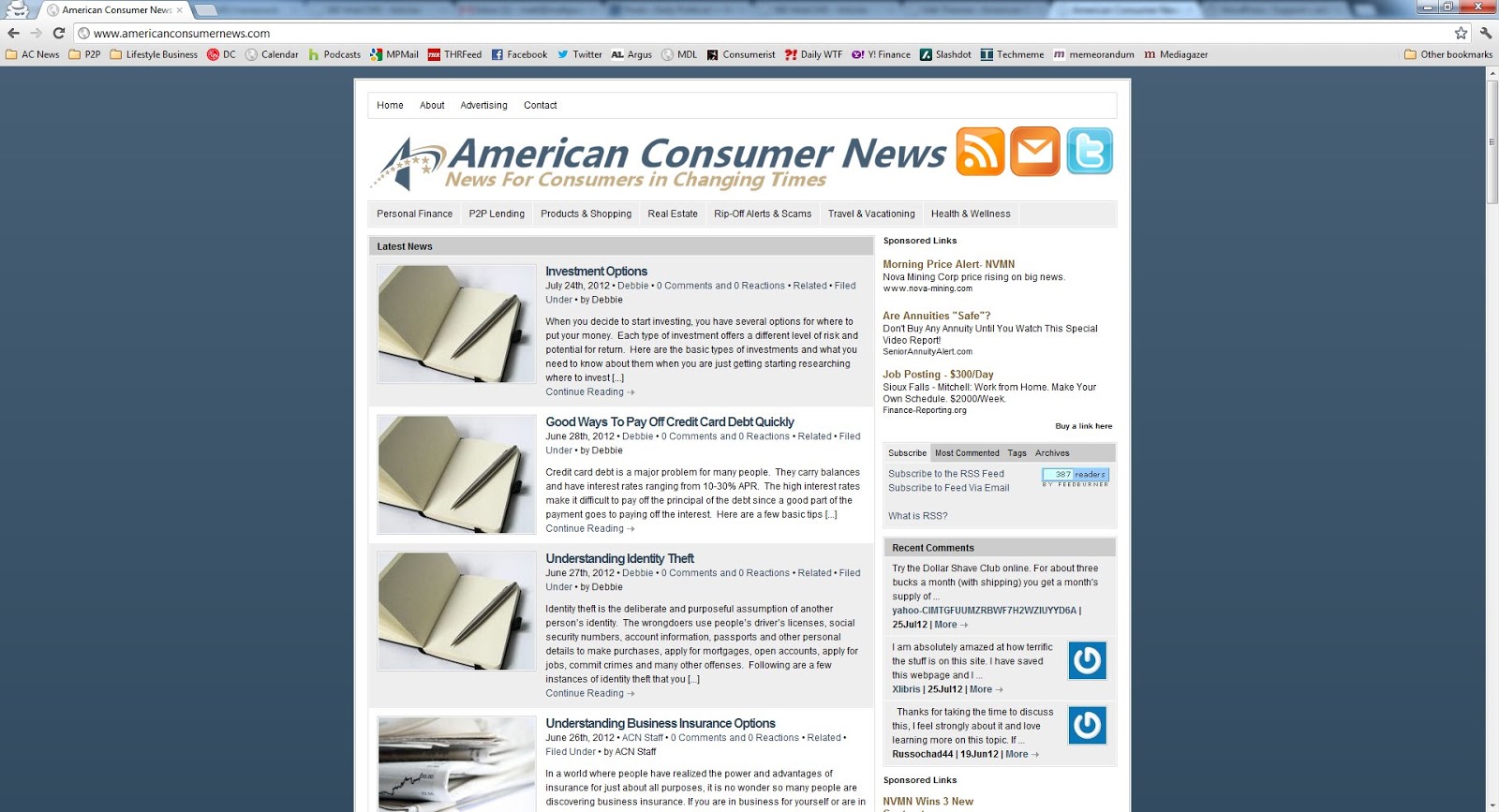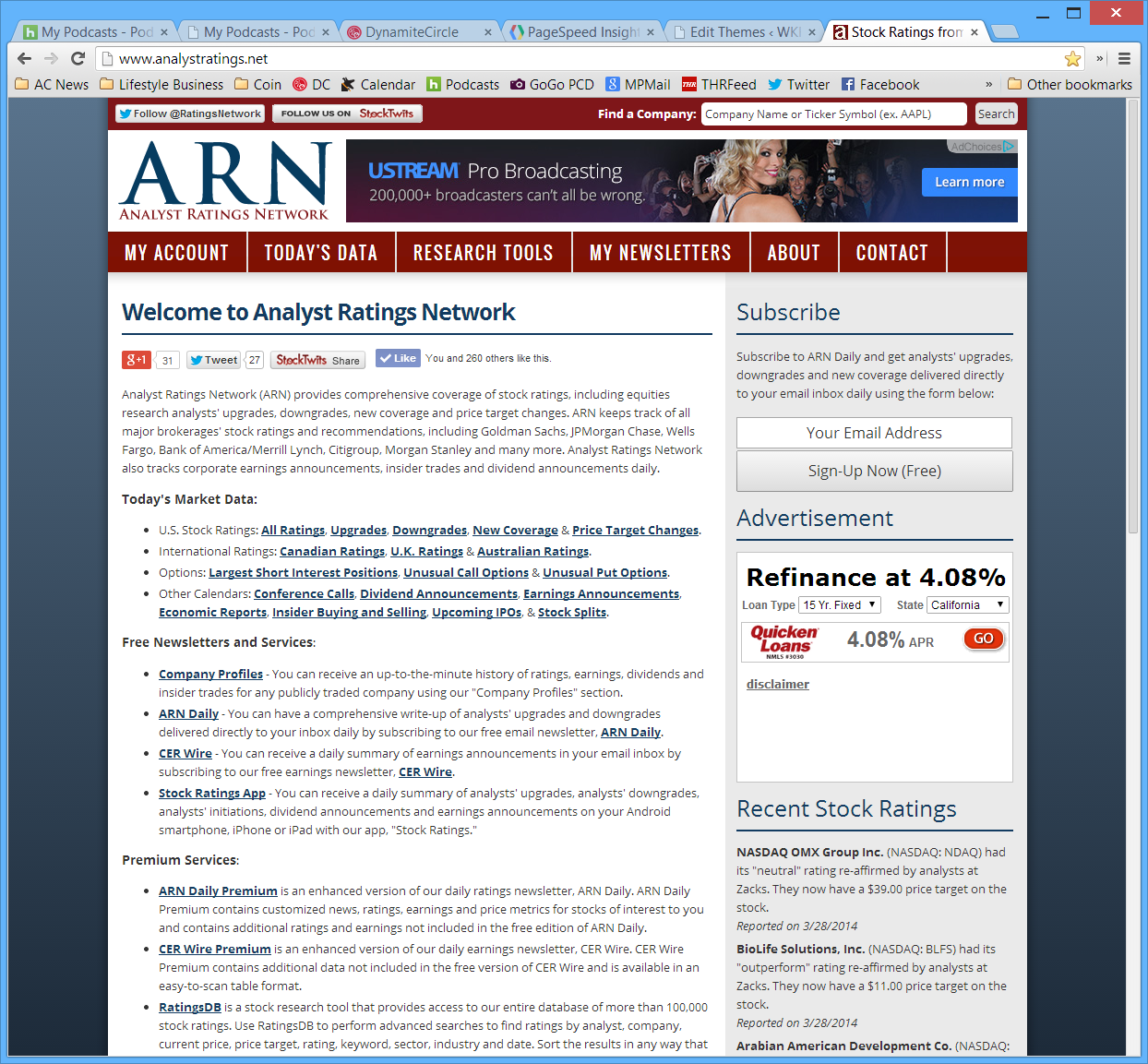How I Started A $36M/Year Stock Market Research Newsletter
Hello! Who are you and what business did you start?🔗
My name is Matt Paulson and I’m the founder of MarketBeat, a financial media company that empowers individual stock investors to make better trading decisions by providing objective financial information and real-time market data.
In other words, we make it easy for investors to research stocks. We publish a series of investment newsletters surrounding different investing strategies, such as following Wall Street analysts’ recommendations or investing in dividend stocks. Our flagship newsletter, MarketBeat Daily Ratings, currently has more than 1 million active email subscribers. Our website, MarketBeat.com, offers a variety of financial calendars, original news content, stock screeners and other investment research tools. MarketBeat’s network of websites attract more than 8 million visitors each month.
Our company operates on a freemium model. We cover our costs for our free subscribers through advertising on our website and in our email newsletters. We also sell premium subscriptions at $20.00-$40.00 per month which provide additional features, data and research tools. Currently about 75% of our revenue is from advertising and 25% is from subscriptions.
MarketBeat is expected to generate approximately $8 million in revenue in 2019 and end the year at about 1.3 million unique email subscribers.

What's your backstory and how did you come up with the idea?🔗
MarketBeat is a business that has evolved and iterated upon overtime. MarketBeat’s predecessor, American Consumer News, started in my college dorm room in 2006.

There weren’t a lot of good ways for me to generate an income as a computer science student in a college town of about 7,000 people. When I was a freshman in college, I worked the cash register and the deep fryer at McDonalds. I knew I didn’t want to repeat that experience the following year. I was able to scrape together an income working a few odd jobs for the university, but what allowed me to graduate debt free was freelance writing.
It turns out that stock investors tend to get emotionally invested in their stocks and want to know the latest tidbits and news headlines about them. We were able to package that information and provide it to our subscribers in a convenient, real-time format.
The first time someone paid me to write an article was in 2005, which I became the technology editor of the university’s student-run newspaper. Soon after, I found other freelance writing jobs on the ProBlogger job board and eked-out $1,000 to $2,000 per month in income as a freelance writer. It didn’t take long for me to figure out that I should start to build my own content brand instead of getting paid a flat-fee per article to build someone else’s brand. I started a personal finance blog called American Consumer News which leveraged the writing skills of myself and other freelance writers to generate advertising income. That blog grew to $5,000 per month in income after two short years.
During the great recession, I accidentally discovered there was an opportunity to write about stocks that were teetering on the edge of bankruptcy. At the time, everyone wondered if Bank of America, Citibank, JP Morgan Chase and Wells Fargo would all go bankrupt due to the subprime mortgage collapse. We would often see 5,000-10,000 readers per article when we wrote about Citibank. This was a big deal on a website that got about 30,000 visitors each month at the time. Our success in writing about stocks and generating website traffic from places like Google Finance, MSN Money and Yahoo Finance led to a pivot from focusing on personal finance to focusing exclusively on investing.
Ultimately, I knew that the recession would end eventually and writing about stocks would be less exciting in the future. We also knew it wasn’t likely that Google, Yahoo and Microsoft wouldn’t keep sending us gobs of free traffic indefinitely, so we started shamelessly collecting email sign-ups on every article we published for a data-driven newsletter that we put together. That way when our traffic stream eventually died out, we could still send email to the people that previously engaged in our content. Initially, we weren’t really making any money from our email list, but I knew it would eventually become a long-term marketing asset.
By the time American Consumer News had pivoted away from personal finance to focus exclusively on investing in 2010 and 2011 and become a brand called Analyst Ratings Network (later renamed to MarketBeat), I had graduated from college and was working as a web programmer for a local digital marketing agency. It took another two years for me to learn how to generate serious income from our newsletter and sell premium subscriptions to our email subscribers.

Take us through the process of designing, prototyping, and manufacturing your first product.🔗
Our email newsletter ended up getting quite a bit of initial traction. It turns out that stock investors tend to get emotionally invested in their stocks and want to know the latest tidbits and news headlines about them.
MarketBeat was able to package that information and provide it to our subscribers in a convenient, real-time format. After about six months of running the free newsletter, it had grown to about 10,000 subscribers. At the same time, I was also getting requests to change the format of the newsletter, add some different data, send it earlier in the day, etc.
I took all of the feedback that I had received and made a premium version of the newsletter and called it MarketBeat Daily Premium. With the premium newsletter, subscribers will get the newsletter earlier in the day, they can get SMS or email alerts for their stocks, have some more customizability for the newsletter and can setup a watch list of their stocks to get more information about the companies they’re most interested in.
MarketBeat is expected to generate approximately $8 million in revenue in 2019 and end the year at about 1.3 million unique email subscribers.
When I launched the premium newsletter in July 2011, I only sold about 30 subscriptions that first month at $15 per month or $150 per year. It was not a big success, but it wasn’t a total failure either. To be honest, I didn’t really know what I was doing at the time. I didn’t know how to properly market the newsletter and I didn’t have the premium product where it needed to be yet. We tried a lot of different things to grow our business and made a lot of mistakes early on, but eventually we began to figure out how a subscription business model can work.
MarketBeat has really grown up since we launched our premium newsletter in 2011. While our basic business model hasn’t changed much, we’ve gotten a lot better at what we do. We’ve built out a product line of additional products and services so that we can sell more to our existing customers.
We changed the name of the business from American Consumer News to Analyst Ratings Network, which was not a good name in retrospect due to its length and lack of memorability. Finally, we were able to acquire the name MarketBeat in 2015.
By adding new marketing channels like co-registration advertising and content marketing, we’ve been able to grow the number of opt-ins we receive from a few thousand each month to more than 30,000 each month. MarketBeat is growing so fast right now that I’ve had to rewrite a lot of the software that sends out the newsletter because of the sheer number of emails we have to send out every day.

Since launch, what has worked to attract and retain customers?🔗
Our primary focus is to grow the number of email subscribers to our free newsletters. I know that if we regularly have new investors sign-up for our free investing newsletters, some of them will click on our advertisers’ ads and buy their products and some of them will buy our products. All of our advertising and marketing surrounds growing our email list. We don’t do brand advertising, display advertising or anything else that doesn’t have a high likelihood of generating an email sign-up for our mailing list.
We generate email sign-ups through a mix of organic search engine optimization efforts and paid advertising. Our SEO strategy relies around being the best website to research any publicly-traded company. So, when an investor goes to search for the name of a company followed by the word stock or simply types in a stock ticker (such as NASDAQ: AAPL), our aim is to be within the first few results. We simply try to be the best place to research a stock by having a ten-year history or a company’s earnings, financials, insider transactions, analyst recommendations, dividend and other information. We don’t buy links or do any form of unethical SEO, but we have done well ranking our website in Google, Bing and Yahoo when people search for stock tickers.
We have been able to get higher than average opt-in rates by aligning the copy of our opt-in forms to the content on the page. If a user is on a page about Microsoft stock, the email opt-in will make specific reference to Microsoft. Our thought is that if a user is researching a particular stock, they are more likely to opt-in to an email list if the opt-in mentions the stock they are researching.
We also currently spend approximately $100,000 per month on paid advertising. These dollars are spent between co-registration advertising networks, content recommendation ads such as Taboola and Yahoo Gemini, and lead generation service providers. Our average cost per email sign-up is currently around $1.00, which is compelling in an industry that says a financial lead should cost an average of $6.00.
We do have some social media marketing efforts in play, but social isn’t a big focus. Our audience is primarily 50-80 year-old men and our customers just don’t spend a lot of time on services like Facebook, Instagram, Snapchat and Pinterest. Some of them use Twitter and StockTwits, so we market into those platforms. However, we’ve never been able to make a Facebook ad work profitably for our company.
How are you doing today and what does the future look like?🔗
As of late 2019, MarketBeat is an $8 million/year business that’s run by seven employees. We have no debt, have healthy retained earnings and operate on a 70% profit margin, so life is pretty good. Other than taxes, payroll, advertising and infrastructure, we just don’t have many hard costs. We hope to generate $10 million in revenue in 2020, but don’t have any other major long-term goals. We’ve already “won the lottery” in the business world by creating a company that throws off $5 million in profit per year with a small team, so we simply try to do a little bit better than we did the year before each year.
Build a business that isn’t dependent on a single customer acquisition source. So many people build businesses that rely exclusively on one channel and then go out of business when their big tech company of choice changes the rules on them.
On the non-financial side, our web traffic and email numbers continue to climb steadily. We’ll be at 1.3 million email subscribers by the end of 2019 and have averaged 9 million pageviews per month over the last several months. We don’t pay much attention to our social media following, but all the numbers worth tracking are heading in the right direction.
This year we launched a major redesign of MarketBeat to put it on the cutting-edge of design in the financial and investing space. We also launched a second brand called The Early Bird that offers a simplified, easy-to-scan newsletter for a younger generation of investors. We’re doing a lot of work surrounding search engine optimization right now (look us up on SemRush, you’ll be impressed). I’m not sure what the next year will look like in terms of launching new products or improving our existing offerings, but our team is always asking “What should we do next?”
Through starting the business, have you learned anything particularly helpful or advantageous?🔗
I’ve learned a bunch of lessons during the 13 years that I’ve been an online business owner and outlined many of those principles in my book, 40 Rules for Internet Business Success.
One “rule” that has helped me build a business that stands the test of time is building a business that isn’t dependent on a single customer acquisition source. So many people build businesses that rely exclusively on Amazon sales, Google search traffic, Facebook ads or App Store sales and then go out of business when their big tech company of choice changes the rules on them. Ideally, your business will have 5-7 repeatable customer acquisition sources in place so that you won’t lose your business if one of your marketing sources just stops working.
Growing a business takes 40+ hours per week of distraction-free work on the right tasks. If you aren’t putting in that effort, success will likely elude you.
A corollary to this is building your audience on platforms that are federated and not tied to any one big tech company. While Facebook can change who sees the posts of your Facebook Page or your Instagram account on a whim, no one tech company can mess with email, podcasts and websites. By building your audience on one of these three technologies that nobody owns, you know that you will still be able to communicate with your audience for years down the road. We’ve been primarily focused on building an email list over the last decade and we have some subscribers that signed-up for MarketBeat in 2011 that continue to receive our emails today. That just doesn’t happen on social media due to algorithm changes and the ephemeral nature of those platforms.
What platform/tools do you use for your business?🔗
MarketBeat is hosted on three bare-metal dedicated servers from LiquidWeb. We use SendGrid to deliver more than 50 million emails each month. We use Twilio for SMS delivery. We use Cloudflare as a content delivery network (CDN) and web firewall. We use Stripe and PayPal for payment processing. We use Slack for team communication. All of our development work is done inside Microsoft Visual Studio.
What have been the most influential books, podcasts, or other resources?🔗
My two favorite business books are Business Brilliant by Lewis Schiff, Never Split the Difference by Chris Voss and The Compound Effect by Darren Hardy.
My favorite business and personal finance podcasts include Dough Roller, Publisher Lab from Ezoic, Startups for the Rest of Us, This Week in Startups and Tropical MBA.
Advice for other entrepreneurs who want to get started or are just starting out?🔗
Talk to your customers! I see this mistake made over and over again. Would-be entrepreneurs assume that they know what problem their potential customers are facing and that they have the solution for it. Instead of doing customer development and identifying what their customers’ problems actually are and what solutions they’ve already tried, they just jump head long into product development and end up building something that nobody wants or needs.
Another mistake that I often see new entrepreneurs make is that many of them just don’t work hard enough and when they do work they focus on things that won’t make them money, such as designing business cards. They spend a lot of time designing their business and thinking about what type of products and services they might offer, but the rubber never really hits the road. It’s easy to think about what a business might be like, but it’s much more difficult to turn that idea into reality. The only two things that cause a business to succeed is building a product or service that there’s demand for and then actually selling it to someone. Everything else is superfluous.
Mike Tyson is famous for saying, “Everybody has a plan until they get punched in the mouth.” This is true both in the boxing ring and in business. Everyone has an idea how their business could work, but they often don’t have the motivation or a true understanding of what it takes to be successful until they’ve tried something and failed. After you’ve been knocked down in business a couple of times, you’ll realize what tasks matter, what tasks don’t, and what the clear path toward success looks like. Growing a business takes 40+ hours per week of distraction-free work on the right tasks (product development and sales/marketing). If you aren’t putting in that effort, success will likely elude you.
Are you looking to hire for certain positions right now?🔗
We currently have a team of seven people and are not actively hiring for any positions. We hired three people this year and probably won’t be hiring anyone for the next 18-24 months.
Where can we go to learn more?🔗
- Website - https://www.marketbeat.com/
- Facebook - https://www.facebook.com/marketbeatcom/
- Twitter - https://www.twitter/MarketBeatNews/
- My Blog - https://www.mattpaulson.com/
- My Books - https://www.amazon.com/Matthew-Paulson/e/B001TA5CW6%3Fref=dbs_a_mng_rwt_scns_share
If you have any questions or comments, drop a comment below!

Download the report and join our email newsletter packed with business ideas and money-making opportunities, backed by real-life case studies.

Download the report and join our email newsletter packed with business ideas and money-making opportunities, backed by real-life case studies.

Download the report and join our email newsletter packed with business ideas and money-making opportunities, backed by real-life case studies.

Download the report and join our email newsletter packed with business ideas and money-making opportunities, backed by real-life case studies.

Download the report and join our email newsletter packed with business ideas and money-making opportunities, backed by real-life case studies.

Download the report and join our email newsletter packed with business ideas and money-making opportunities, backed by real-life case studies.

Download the report and join our email newsletter packed with business ideas and money-making opportunities, backed by real-life case studies.

Download the report and join our email newsletter packed with business ideas and money-making opportunities, backed by real-life case studies.












